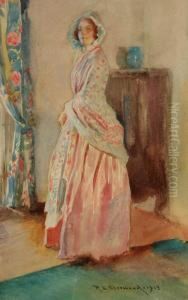Rosina Emmet Sherwood Paintings
Rosina Emmet Sherwood was an American painter and illustrator, born into a prominent New York family with a rich artistic legacy. She was born on September 13, 1854, in New Rochelle, New York, and was one of the ten children of William Jenkins Emmet and Julia Colt Pierson. She was also the niece of the famed Irish-American portraitist, Thomas Addis Emmet. Her family environment was a nurturing ground for her artistic talents, and she received encouragement to pursue her interests in art from an early age.
Sherwood showed artistic promise early in her life and sought to develop her skills through formal education. She studied at the Cowles Art School in Boston and later at the Art Students League of New York. During her time at the Art Students League, she was taught by prominent artists of the time, including William Merritt Chase, a leading figure in American Impressionism. Sherwood also studied with the well-known genre painter Thomas W. Dewing.
In the 1880s, Sherwood's work began to gain public attention. She became known for her illustrations that appeared in publications such as 'Harper's Weekly' and 'St. Nicholas Magazine.' Her illustrations often featured children and domestic scenes, reflecting a gentle, sentimental style popular in the late 19th century. Sherwood was also a member of the Society of American Artists and contributed to various exhibitions.
Aside from her illustrations, Sherwood was an accomplished painter. She is known to have exhibited her work at the Paris Salon, an esteemed venue for artists of the time. Her paintings often depicted social and domestic scenes, portraits, and landscapes. Her style was influenced by her academic training but also incorporated elements of Impressionism, particularly in her use of light and color.
Rosina Emmet Sherwood's artistic career was somewhat overshadowed by the success of her more famous cousins, Lydia Field Emmet, Ellen Emmet Rand, and Jane Erin Emmet de Glehn, all of whom were also accomplished artists. Despite this, Sherwood made her own mark in the art world with her delicate and refined illustrations and paintings.
She married Arthur Murray Sherwood in 1884, and while she continued to paint after her marriage, her output decreased as she dedicated more time to her family and domestic life. Sherwood lived through significant periods of change in American art, from the genteel aesthetics of the Gilded Age to the emergence of modernism. She died on October 16, 1948, leaving behind a body of work that contributes to our understanding of American art in the late 19th and early 20th centuries.






